
Lately I’ve been enjoying the music of the monks at Keur Moussa Abbey, a brotherhood of French expatriates and Senegalese who wed Western liturgical chant with the rhythms and instrumental textures of West Africa. One of their income streams is musical recording sales—in North America, for example, Sounds True distributes Keur Moussa: Sacred Chant and African Rhythms from Senegal. It’s an excellent, seventeen-track CD that comprises songs of praise, exhortation, confession, and supplication in French and Wolof. Below you will find two of those tracks, embedded with the kind permission of Sounds True.
The first is “Suma Hol Nam” (“I Was Glad”), an adaptation of Psalm 122 in Wolof, accompanied by tom-tom. “Let peace reign in your tents, joy within your walls!” it exclaims. The refrain is “How glad I was when they said to me, ‘Let us go to the house of the Lord.’”
The second is “Yesu Dekalikuna” (“Jesus Is Risen”), a brisk instrumental kora interlude that evokes the holy women hastening from the tomb on Easter morning.
From the liner notes:
In 1963, nine monks from the French monastery of Saint-Pierre of Solesmes—a centuries-old stronghold of the ancient Gregorian plainchant tradition—journeyed to the remote Wolof village of Keur Moussa in Senegal to found the Benedictine Abbey of the Immaculate Heart of Mary [Abbaye du Cœur Immaculé de Marie]. Keur Moussa Abbey, as it is known to the villagers, means “House of Moses.” It is above all a place of prayer, where praise of God is celebrated through hard work, contemplative silence, and joyful music. From the first day of their arrival, these expatriate monks sought to invite the traditions, music, and people of their host village into the monastery grounds.
Today, Keur Moussa Abbey houses 35 brothers, 24 of whom are Senegalese. [According to OSB International, the current number of brothers is 44.] The abbey also sponsors an elementary school and dispensary, run by sisters and laypeople. The monks themselves live from the work of their hands, tending fruit trees, making cheese, and hand-crafting their renowned koras.
The kora, employed for both solos and accompaniment, is an African lute-harp of Mandingo origin. Enchanted by its lyrical voice, the first monks of Keur Moussa Abbey learned from the griots (nomadic Mandingo kora players and storytellers) to play the instrument, and eventually adapted it for use in their liturgical services. Through careful changes in the kora’s construction, they have made it easier to tune—a process that once frustrated even the most experienced of players—without altering its extraordinarily beautiful timbre. . . .
Through the continual exploration of their convergent musical worlds, the monks of Keur Moussa have created an entirely new liturgical choral tradition . . . weav[ing] the rhythms and instrumental textures of the African continent with the sacred words and compositional structures of traditional Western plainchant (sung in French and Wolof, the language of the region). Here, as in the daily masses at the abbey, the choral works are occasionally preceded or followed by instrumental performances on kora, tabala (a large Mauritanian camel-skin drum), balafon (a Malinke instrument similar to the xylophone), tom-tom, and flute.
The notes include English translations of all the songs, plus background information on each one.
The kora, for which Keur Moussa is best known, is a mix between a harp and a lute, possessing (traditionally) twenty-one strings that run in two divided ranks and are held in notches on a bridge, and a resonating chamber built from a large calabash cut in half and covered with cow skin. Koraists hold the instrument upright, using the thumb and index finger of both hands to pluck the strings in polyrhythmic patterns. When played in the traditional style, the music bears resemblance to flamenco and delta blues guitar.
Originating in the sixteenth century among the Mandinka people of West Africa, the kora is played in Senegal, Guinea, Guinea-Bissau, Mali, Burkina Faso, and the Gambia. Traditionally, koraists come from jali families (French griot; Wolof guewel; English bard); that is, they serve as a repository of oral tradition—as historians, genealogists, and storytellers—and pass on this role, and requisite knowledge, to their descendants. However, since the latter half of the twentieth century, kora playing has extended beyond this framework, such that some players do not belong to a jali lineage, and they often perform in different contexts.
The founding monks of Keur Moussa were trained on kora by two jalis, after L’Institut fondamental d’Afrique noire (IFAN) gifted the abbey with a kora. But over time they adapted both the style of playing and the instrument itself for liturgical use. Traditional koras are not chromatic (that is, they cannot play “sharps” and “flats”), so they lack a degree of versatility; moreover, learning to tune them properly is just as difficult as learning how to play them, and the leather rings bound around the neck (called konso rings) don’t hold the strings’ pitches very long before needing adjustment.
In 1971, to allow for easier tuning, Br. Michael Meugniot replaced the konso rings with conical wooden knobs, which required an elongation of the instrument’s neck. In the 1980s Br. Luc Bayle further modified the design by replacing the wooden knobs with metal ones and adding levers that allow for easy switching between major and minor keys. The monks at Keur Moussa produce and sell these chromatic koras, as well as give lessons on them to music students from around the world, both lay and religious. All incoming monks learn how to play the kora.
In addition, the monks have developed a method of written kora music, including a system of indicating notes on a staff and their rhythmic values. (Traditionally, kora music was composed and transmitted orally.)
In a 2009 interview, Br. Jean Baptiste, who is Senegalese, said that the use of the kora in mass enables him and his African brothers to worship in spirit and in truth.
Keur Moussa has a YouTube channel, where you can watch masses, see the grounds and interior of the abbey, and hear more of the beautiful music produced there.
“Sur tes murailles Jérusalem” (“On Your Walls, Jerusalem”), from Quand renaît le matin:
“Te Deum” (“Thee, O God”):
“Borombi,” from Sénégal: Messe et chants au Monastère de Keur Moussa:
+++
Not only does the liturgical music of Keur Moussa Abbey represent a fusion of cultures; so does its artwork. The gridded, four-by-five-tile reredos in the chapel has iconographic features in common with western European art, but the biblical characters are Senegalese. The recurring figure of Mary (the abbey’s namesake), for example, wears a traditional embroidered boubou and a head wrap.
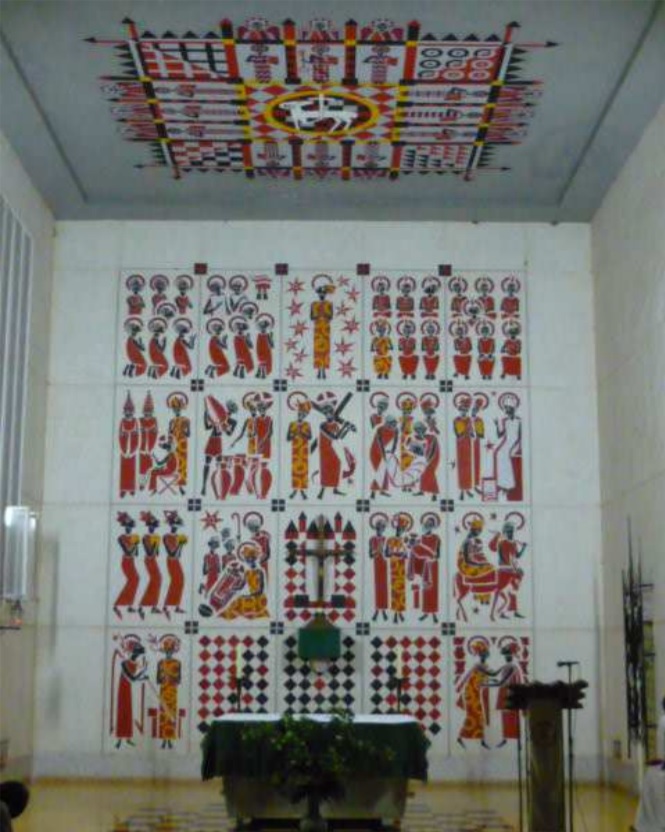


Other artworks can be found in the abbey’s newsletter archives and, sparsely, across the Internet. My repeated efforts to contact the abbey for further information on these works, such as artist name and year of composition, were unsuccessful.
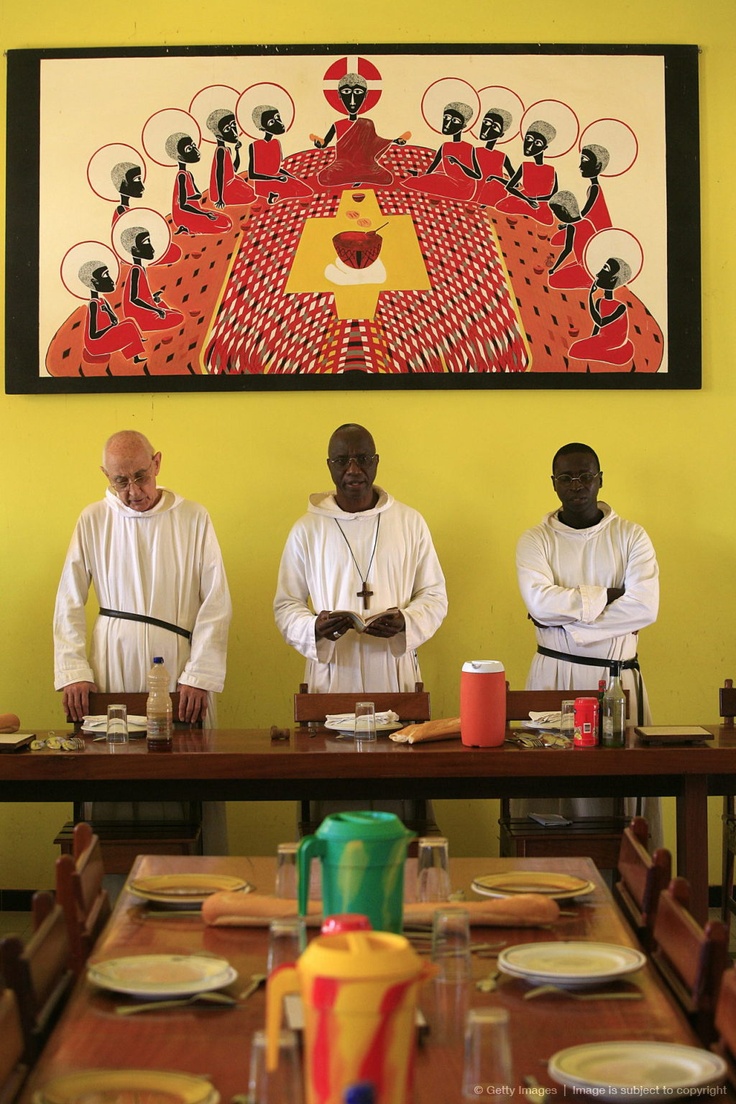
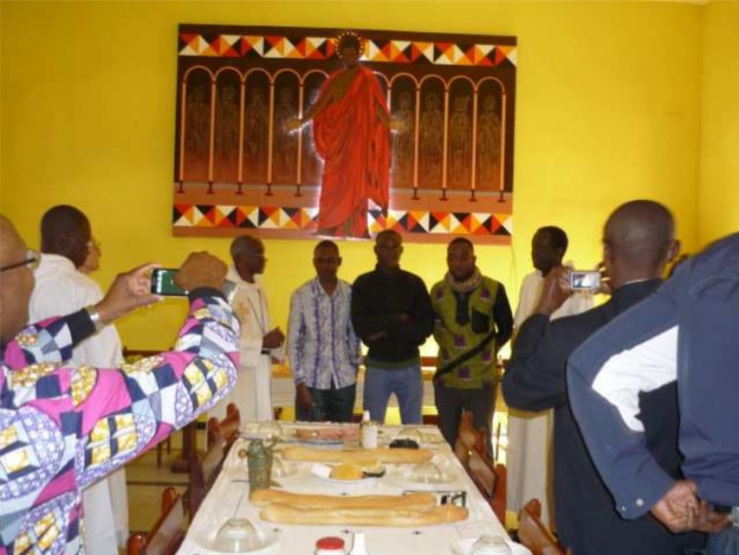
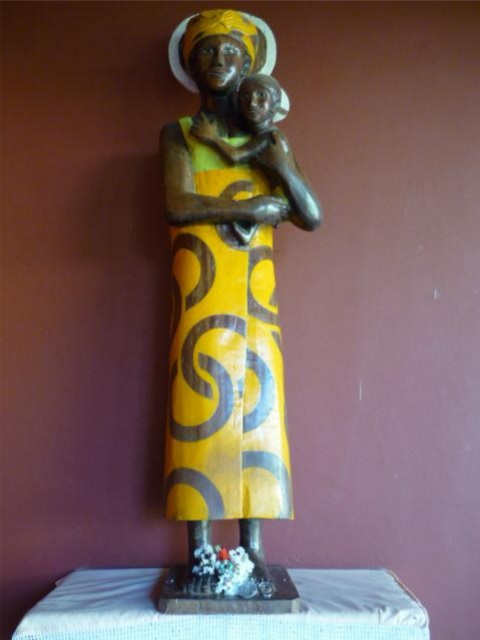
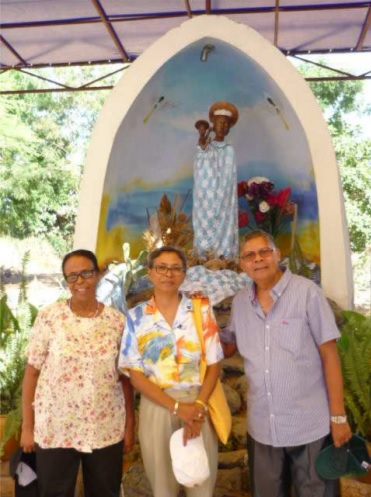
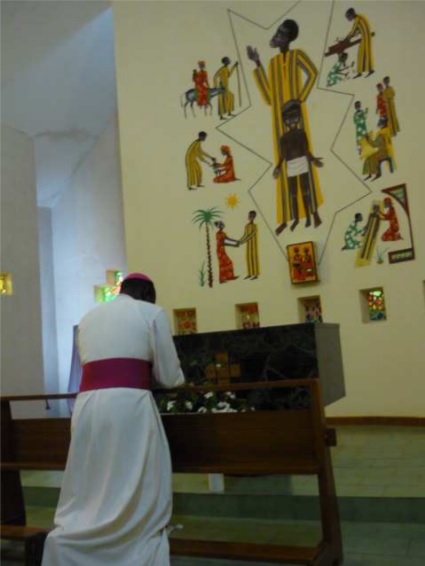
Click here to view additional photos from Keur Moussa Abbey and village, by Robert Harding.
+++
Not far from this community of brothers is a community of sisters at Keur Guilaye Abbey, founded in 1967 by Benedictine nuns of St. Cecilia’s Abbey in Solesmes, France; it, too, is home to both French and Senegalese, and the two abbeys often worship together and collaborate on projects.
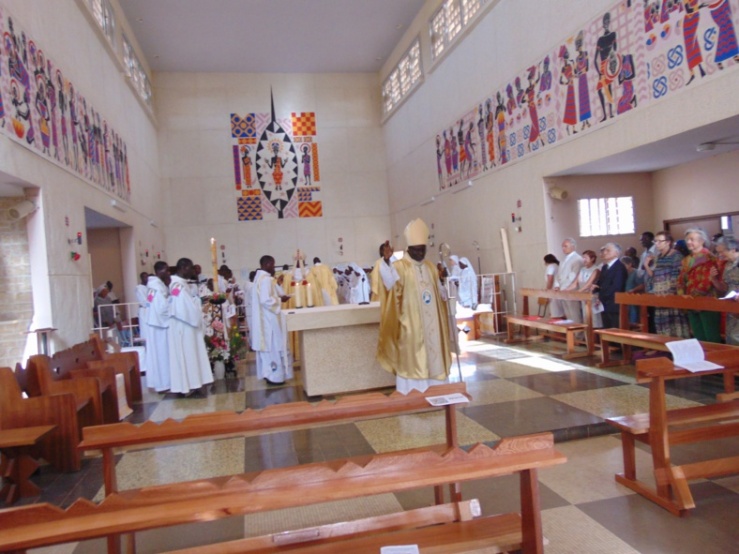
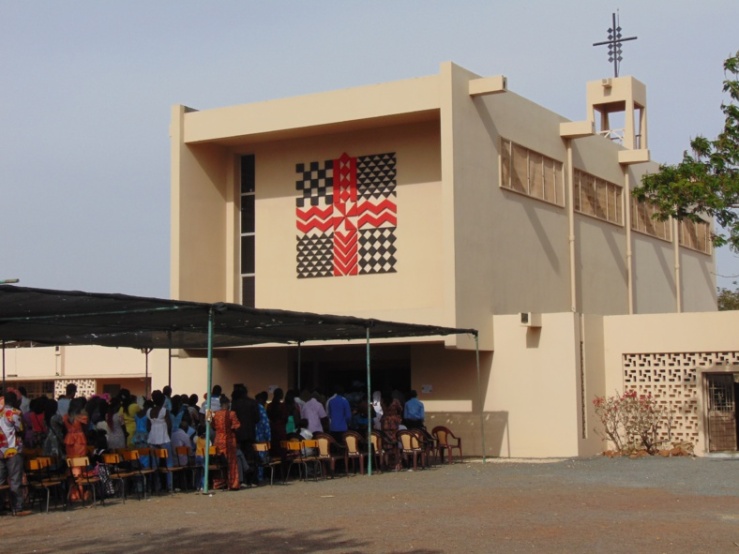
Keur Guilaye Abbey was elevated from the rank of priory in 2008, and just this year it celebrated its golden jubilee. Its official name is the Abbey of St. John the Baptist, and to that end its chapel interior boasts a fresco cycle of the life of this saint, this forerunner to Christ. The following images are screenshots I took from the YouTube video “Jubilé d’or Keur Guilaye”; the labels are ones I’ve given them and therefore don’t indicate their official titles. John the Baptist can be identified as the one in a ragged red-and-blue garment, and Jesus is the one with a cruciform halo.


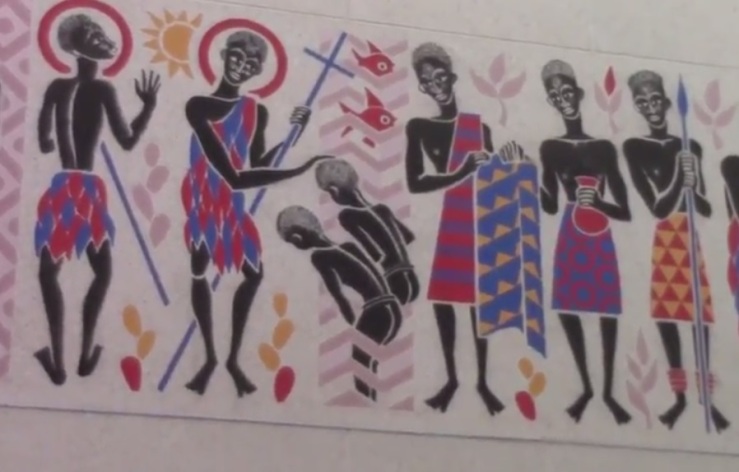
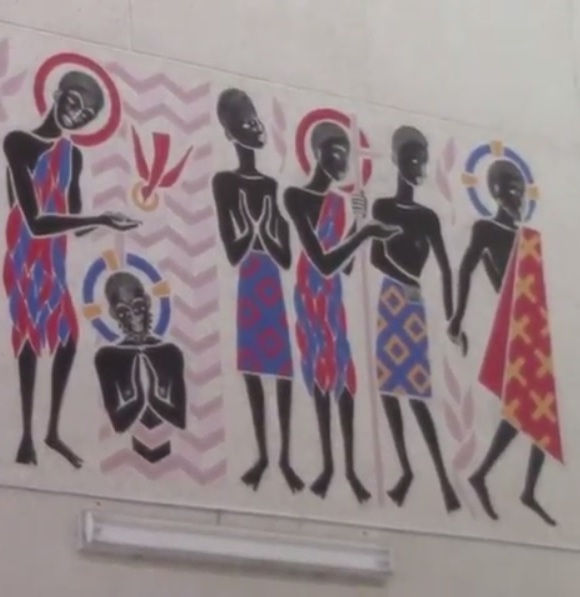
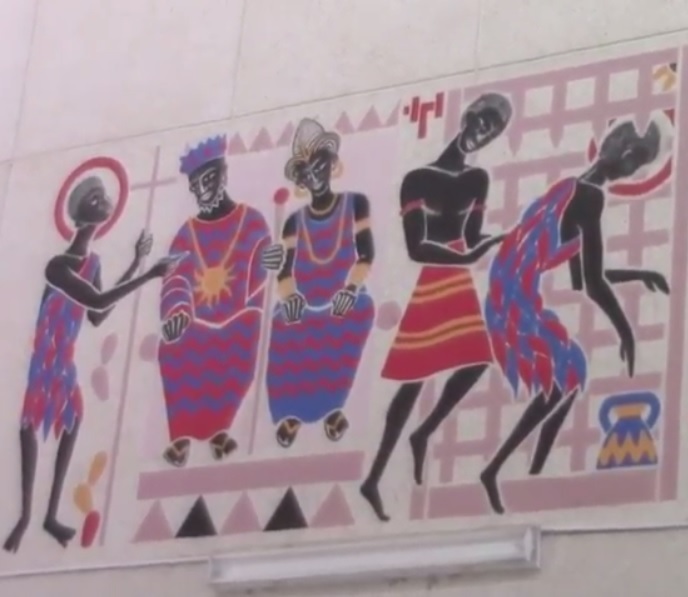
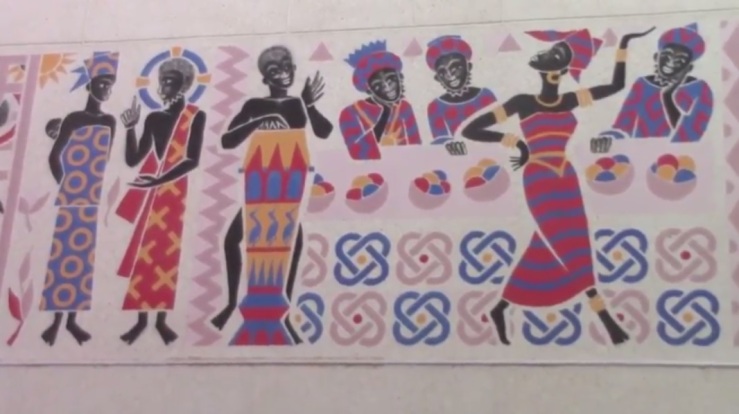
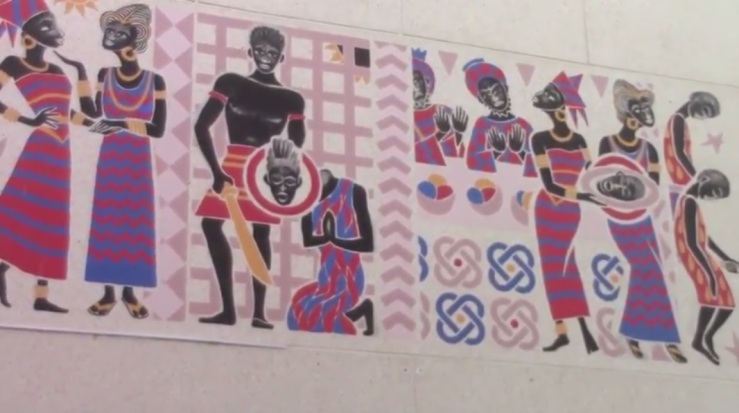
The central image in the chapel, however, is a fresco above the altar depicting Christ seated in majesty between the Virgin Mary and John the Baptist, displaying his glorified wounds. Opposite this, on the west wall, is a large crucifix, the corpus sculpted but the cross and the rest of the scene painted directly onto the wall. Again, Mary and John flank Christ.

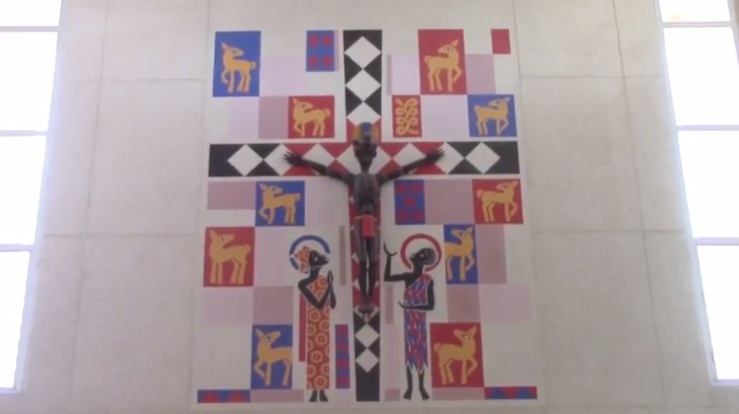
The sisters at Keur Guilaye are also known for their kora playing, a rare practice among women (traditionally, it was restricted to men). Their music can be heard on the album Voici l’Agneau de Dieu (Behold the Lamb of God).
+++
Further Reading:
Frère Dominique Catta et Frère Luc Bayle, “La kora de Keur Moussa,” Voix d’Afrique 85 (1991).
Emily Merkert, “Learning the Kora in Two Senegalese Contexts: As a Tradition vs. As a Religion,” Alfred University, Spring 2009.
+++
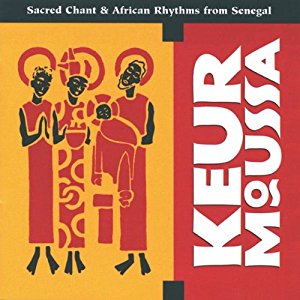

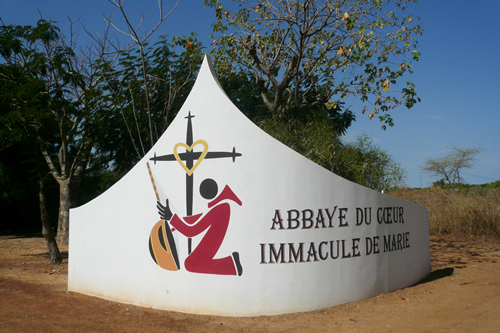


I love this music. However I speak very little French but want to sing along. I’ve lost the CD cover 😢. Is there anyway I can get the lyrics in the Senegalese French especially for Offices du Dimanche and in particular Encore in peu de temps.
LikeLike
I have lyrics only for the 17 songs on Keur Moussa: Sacred Chant and African Rhythms from Senegal, which doesn’t include the two you mention. Sorry!
LikeLike
I love this music as well!!!! Where can I get the lyrics in English??? Thank you!
LikeLike
Again, the Keur Moussa: Sacred Chants CD sleeve includes English translations of the lyrics (the CD has a North American distributor). The other CDs are distributed in France, I believe, and probably do not. I was not able to find translations online, and the abbey was not responsive to the emails I sent them at the time of this post. Here are the full lyrics to “Suma Hol Nam (I Was Glad)”:
Refrain: How glad I was when they said to me, “Let us go to the house of the Lord.”
1. I was glad when they said to me, “Let us go to the house of the Lord.”
2. O Jerusalem, here we are within your walls, in the city so firmly bound together, to which the tribes go up, the tribes of the Lord.
3. As was decreed for Israel, to praise the name of the Lord. Thrones of justice have been set there, the thrones of David’s house.
4. Request days of happiness for Jerusalem: let peace reign in your tents, joy within your walls! Peace unto your castles.
5. Out of love for my brothers and friends, I ask for peace. Out of love for the house of God, I pray for your happiness.
LikeLike
Thank you so much! I ordered the cd 🙂
LikeLike
[…] Kyrie (“Lord, have mercy”)—by Hildegard of Bingen, Josquin des Prez, Isaac Wardell, and the monks of Keur Moussa Abbey in Senegal (sung in Wolof). Plus the fourteenth-century prayer known as the Anima Christi, with […]
LikeLike
I listened to Suma Hol Nam today for the first time while continuing with Sacred Space Lenten retreat. This sacred music is so beautiful and joyous .I’m so glad to have discovered it. Thank you Victoria for your translation.
LikeLike
Thank you for this write-up. I just discovered the music from Keur Guilaye Abbey and bought their one and only album (I think, please correct me if I’m wrong about that). I find myself listening to it often. I actually prefer it to the Keur Moussa Abbey, but enjoy both. Such a joyful style of chant.
LikeLike
[…] to “Ç’était nos souffrances qu’il portait” by the monks of Keur Moussa Abbey in Senegal [previously], but its French title, taken from Isaiah 53:4, translates to “It was our sufferings that he […]
LikeLike
[…] From Abbaye Keur Moussa, Senegal […]
LikeLike
I host a music show of African music & just discovered this while putting together a program on the Kora. Thank you for this information, the graphics are amazing. And the music, exquisite!!!
LikeLike
[…] (Related post: “Music making at Keur Moussa Abbey, Senegal”) […]
LikeLike
[…] the Atlantic, the monks of Keur Moussa Abbey [previously] in Senegal sing “Nous Te Louons, Père Invisible” (“We Praise You, Invisible Father”), […]
LikeLike
[…] (Related posts: “‘River’ by Eugene McDaniels”; “Music making at Keur Moussa Abbey, Senegal”) […]
LikeLike
[…] the 2022 New Yorker profile “The Monks Who Took the Kora to Church” by Julian Lucas, or the blog feature I published in 2017. I also shared their musical setting of the “Vidi aquam” in Wolof last Easter, along with a […]
LikeLike